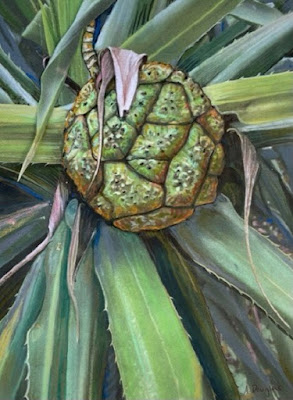 |
| Pandanus estellae Rozefelds, Rudall, Herne, Milroy & Bridgeman, 2022 DOI: 10.1086/719431 |
Abstract
Premise of research. The Capella region in central Queensland has yielded diverse, three-dimensionally preserved, permineralized floras that are associated with 32–28 Ma Cenozoic volcanics. A new fossil infructescence that was recently discovered from a new locality is shown to have affinities with Pandanus Parkinson, and it is described herein as Pandanus estellae sp. nov.
Methodology. The affinities of the material were assessed according to a literature review of families that have syncarpous fruits or cones. The specimen was studied and photographed using conventional macromorphological approaches. Micro–computed tomography scanning was used to ascertain whether the internal structure of the fruit was preserved.
Pivotal results. The single infructescence consists of several basally connate segments that lack a clear phyllotactic pattern and are variable in size and shape; the external surface of each segment is irregularly pentagonal-hexagonal and strongly coalescent. Each segment is interpreted as multicarpellate. Collectively, these features allow interpretation of the fossil as syncarpous, and the morphological features support placement in the monocot family Pandanaceae. The arrangement of segments is consistent with the polydrupes that characterize most species of Pandanus, but the small size of the infructescence of P. estellae differs from fruits of modern species in the genus, which are typically much larger. The anatomy of P. estellae is not preserved. The inferred Early Oligocene age for the fossil fruit predates current estimates, which are based on molecular data and limited calibration points, by about 8–10 Myr for the split of Benstonea Callm. and Buerki from Pandanus.
Conclusions. The new species P. estellae is significant because it provides credible pre-Pleistocene evidence of the genus and is the oldest unequivocal fruit of Pandanus currently known. Its occurrence in Australia supports a Gondwanan history for the family.
Pandanus estellae sp. nov.
Andrew C. Rozefelds, Paula J. Rudall, Matt C. Herne, Anita K. Milroy and Joe Bridgeman. 2022. A Fossil Syncarpous Fruit from Australia Provides Support for a Gondwanan History for the Screw Pines (Pandanus, Pandanaceae). International Journal of Plant Sciences. 183(4); DOI: 10.1086/719431
